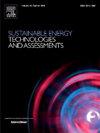Optimal conditions to maximize the fixed carbon content and the gas higher heating value of chrome-tanned leather shavings (CTLS) processed through fast pyrolysis
IF 7.1
2区 工程技术
Q1 ENERGY & FUELS
Sustainable Energy Technologies and Assessments
Pub Date : 2025-01-01
DOI:10.1016/j.seta.2024.104134
引用次数: 0
Abstract
Chromium remains a major obstacle to environmentally friendly management of the massive amounts of leather waste produced by tanneries worldwide. Pyrolysis has been considered an interesting cost-benefit solution because the remaining char fixes carbon and the gases contain energy that can be reused in the process. Nevertheless, the optimal pyrolysis conditions must be determined to maximize carbon sequestration, minimize the volume of Cr-containing char and produce gases with the highest heating value. This study investigated the fast pyrolysis of chrome-tanned leather shavings (CTLS) containing 2.84 wt% Cr (dry basis) to determine the optimal conditions for industrial scaleup. The partitioning of CTLS into char, liquid, and gas was investigated at heating rates of 41–76 °C/min, temperatures of 400–800 °C, and residence times of 15–60 min. The best pyrolysis condition was 15 min at 400 °C, which produced 659 gchar/kgCTLS, with 38 wt% fixed carbon. This condition also resulted in 106 ggases/kgCTLS, with 17.2 wt% light hydrocarbons (C1-C5), and an estimated higher heating value of 7.2 MJ/kg. The resulting chars had Cr content in the trivalent state (Cr3+) ranging from 4.3 to 5.2 wt%, and despite the high calorific value, they should not be used as fuel without a robust flue gas post-treatment system.
求助全文
约1分钟内获得全文
求助全文
来源期刊

Sustainable Energy Technologies and Assessments
Energy-Renewable Energy, Sustainability and the Environment
CiteScore
12.70
自引率
12.50%
发文量
1091
期刊介绍:
Encouraging a transition to a sustainable energy future is imperative for our world. Technologies that enable this shift in various sectors like transportation, heating, and power systems are of utmost importance. Sustainable Energy Technologies and Assessments welcomes papers focusing on a range of aspects and levels of technological advancements in energy generation and utilization. The aim is to reduce the negative environmental impact associated with energy production and consumption, spanning from laboratory experiments to real-world applications in the commercial sector.
 求助内容:
求助内容: 应助结果提醒方式:
应助结果提醒方式:


